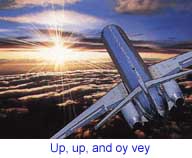
|

|
Jewish World Review / March 17, 1998 / 19 Adar, 5758
By Carol Cott Gross
WHEN GAIL ROSEN won an all-expense-paid vacation to Hawaii earlier this year, she didn't break out the champagne; she broke into a cold sweat.
"I'm forced to fly for business," explained the 32-year old attorney, "but no way would I would I put myself through the unnecessary torture of a flight to Hawaii. My idea of a perfect trip to The Islands --- is Long Island and Staten Island."
When Miss Rosen must fly, she is filled with anxiety: "If the flight is bumpy, I expect the plane to fall from the sky. If it's smooth, I imagine that we're caught in a sci-fi state of suspended animation. If the pilot is young, I'm sure that he's on drugs; if he's old, I'm just as sure that he's about to have a heart attack." She says that she's prone to Jewish Guilt Trips when she's traveling for pleasure. She explains: "When I fly for business, I don't worry as much. It's like, 'Listen, I'm not having fun! I have to fly!' On a vacation, I feel more vulnerable."
Though Miss Rosen's fears are exaggerated and unrealistic, her negative attitude about flying is not uncommon. Experts say that 25 million Americans are afraid to fly. And the TWA and Valujet accidents have undoubtedly increased the ranks of "white knuckles," while reinforcing the fears of those who don't leave terra firma at all.
Some aviaphobics (a newly coined term for people who are plane-scared) claim they'd fly fearlessly if it were possible to guarantee a safe flight. However, the fear flying isn't necessarily a fear of dying in a plane crash.
In 1969, my father, the late Nate Cott, founded Fly Without Fear, a New York City based support program at La Guardia Airport. It was the first of its kind. There are now 30 similar programs in the U.S. My father dubbed his own anxiety about flying his Stop The World, I Want To Get Off syndrome. "The reason I stayed off planes," my father explained, "was because I wanted to fly the plane myself, or at least open the window during a flight to let in fresh air."
Some aviaphobics fear heights, a fear also related to the control syndrome. "My fear of heights prevented me from enjoying the view from a friend's New York apartment," explained my father. "When I looked down, I had the sensation of falling. On a plane, I was afraid that if the pilot told us we were cruising at 20,000 feet, I become anxious because I couldn't get back down on the ground when I felt anxious. "Psychologists don't really know why some people develop flying phobias. The prevailing theory is that it's a combo of hereditary predisposition and imitative factors. Many transportation phobics describe their parents as pessimistic, superstitious, and over-protective. It's interesting, that since 1969, when Fly Without Fear began, 80% of the members are Jewish or Italian.
Some psychologists believe that periods of intense personal change and stress, particularly, between the ages of 22 to 30, can aggravate transportation phobias in individuals who have a tendency to develop them. According to Dr. Martin Sief, Ph.D., a New York psychologist, the change can be positive (i.e. graduation from college, beginning a career, getting married) or negative (i.e. losing a parent, suffering a serious illness). If a confirmed aviaphobic has a "bad" flight (turbulence, circling, delays) the phobia will be reinforced and the traveler will stop flying. The longer the person stays grounded, the more difficult it becomes to take the next flight.
Directors of fearful-flyer programs report that the majority of their members are female, perhaps because women are more willing to join a group and work towards overcoming their aviaphobia, while men tend to hide their fears. It's not unusual for women to experience travel-related fears develop soon after becoming mothers. "What if something happens to me on a plane? Who's going to take care of the baby?" is a typical worry.
If you're a white knuckler, you can learn to control the symptoms ... the sweaty palms, heart palpitations, nausea, and dizziness. Dr. Seif suggests replacing negative in-flight fantasies with comforting images like: the plane as a balloon with the string attached to the ground, the plane as a gently rocking cradle in the sky. "These images are unrealistic," notes psychologist Self, "but no more unrealistic than imagining that the wing is falling off.
Another self-help hint is to identify the thought or sensation that triggers your fear response. During a flight, chart your fear levels on paper to distance yourself from your fear response: 0 indicates no fear; 10 means a state of panic. The chart will help you see that you are not at the full-panic stage during the entire flight. Travel companions of white-knucklers can be helpful by reminding their travelmates to "stay in the present and stop imagining negative possibilities."
Captain Tony Vallillo of American Airlines has worked with groups of aviaphobics. He advises first-time or fearful flyers to meet the pilot upon boarding the plane and ask questions. "The airlines are aware that a lot of people are nervous when they fly. We want to make you comfortable so you'll keep flying."
When planning a flight, don't make alternative train reservations. If you must take the train, encourage your travel companion to fly without you. Accompanying you on the train will only serve to give approval to your fears. To find out more information about Fly Without Fear, and costs for weekly meetings at La Guardia Airport, or a packet of self-help tips, phone: 212/697-7666.
And here are some hints to help you leave terra firma, without the terror:
 Your fright is now boarding
Your fright is now boarding
Jews who can't fly, winging it
New JWR contributor, Carol Cott Gross, is a Long Island-based writer.